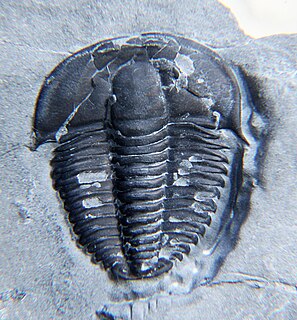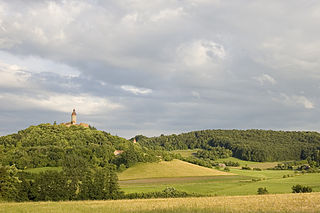Related Research Articles

Franconia is a region in Germany, characterised by its culture and language, and may be roughly associated with the areas in which the East Franconian dialect group, colloquially referred to as "Franconian", is spoken. There are several other Franconian dialects, but only the East Franconian ones are colloquially referred to as "Franconian".

The Silurian is a geologic period and system spanning 24.6 million years from the end of the Ordovician Period, at 443.8 million years ago (Mya), to the beginning of the Devonian Period, 419.2 Mya. The Silurian is the shortest period of the Paleozoic Era. As with other geologic periods, the rock beds that define the period's start and end are well identified, but the exact dates are uncertain by a few million years. The base of the Silurian is set at a series of major Ordovician–Silurian extinction events when up to 60% of marine genera were wiped out.

Lower Franconia is one of seven districts of Bavaria, Germany. The districts of Lower, Middle and Upper Franconia make up the region of Franconia.

Upper Franconia is a Regierungsbezirk of the state of Bavaria, southern Germany. It forms part of the historically significant region of Franconia, the others being Middle Franconia and Lower Franconia, which are all now part of the German Federal State of Bayern (Bavaria).

The Fichtel Mountains, form a small horseshoe-shaped mountain range in northeastern Bavaria, Germany. They extend from the valley of the Red Main River to the Czech border, a few foothills spilling over into the Czech Republic. They continue in a northeasterly direction as the Ore Mountains, and in a southeasterly direction as the Bohemian Forest. The Fichtel Mountains contain an important nature park, the Fichtel Mountain Nature Park, with an area of 1,020 square kilometres (390 sq mi).

West Central German belongs to the Central, High German dialect family of German. Its dialects are Franconian and comprise the parts of the Rhinelandic continuum located south of the Benrath line isogloss, including the following sub-families:

East Franconian (German: Ostfränkisch, usually referred to as Franconian in German, is a dialect which is spoken in Franconia, the northern part of the federal state of Bavaria and other areas in Germany around Nuremberg, Bamberg, Coburg, Würzburg, Hof, Bayreuth, Meiningen, Bad Mergentheim, and Crailsheim. The major subgroups are Unterostfränkisch, Oberostfränkisch and Südostfränkisch.

The Franconian Circle was an Imperial Circle established in 1500 in the centre of the Holy Roman Empire. It comprised the eastern part of the former Franconian stem duchy—roughly corresponding with the present-day Bavarian Regierungsbezirke of Upper, Middle and Lower Franconia—while western Rhenish Franconia belonged to the Upper Rhenish Circle. The title of a "Duke of Franconia" was claimed by the Würzburg bishops.

The Franconian Forest, is a mid-altitude mountain range in Northern Bavaria, Germany. It is located in the district of Upper Franconia (Oberfranken) and forms the geological connection between the Fichtelgebirge and the Thuringian Forest. It is a broad well-wooded plateau, running for about 45 kilometres (28 mi) in a northwesterly direction, descending gently on the north and eastern sides towards the Saale river, but more precipitously to the Bavarian plain in the west, and attaining its highest elevation in the Döbraberg near Schwarzenbach am Wald. Along the centre lies the watershed between the basins of the Main and the Saale, belonging to the systems of the Rhine and Elbe respectively.

The Duchy of Franconia was one of the five stem duchies of East Francia and the medieval Kingdom of Germany emerging in the early 10th century. The word Franconia, first used in a Latin charter of 1053, was applied like the words Francia, France, and Franken, to a portion of the land occupied by the Franks.

Franconian or Frankish is a collective term traditionally used by linguists to refer to many West Germanic varieties, most of which are spoken in what formed the historical core area of Francia during the Early Middle Ages. Linguistically, there are no typological features that are typical for all the various dialects conventionally grouped as Franconian. As such, it forms a residual category within the larger historical West Germanic dialect continuum rather than a homogeneous group of closely related dialects. For most of the varieties grouped under the term "Franconian", the diachronical connection to the Frankish language, which was spoken by the Franks, is unclear.
Main-Franconian is group of Upper German dialects being part of the East Franconian group. The name is derived from the river Main which meets the river Rhine near Frankfurt after having crossed the former West Germany from East to West. The dialect is estimated by Ethnologue as 40% intelligible with Standard German.

Plectronocerida is a primitive order from which subsequent cephalopod orders are ultimately derived.

Franconia is a region for quality wine in Germany situated in the north west of Bavaria in the district of Franconia, and is the only wine region in the federal state of Bavaria. In 2014, vines were grown on 6,176 hectares of land in the region.
The Dresbachian is a Maentwrogian regional stage of North America, lasting from 501 to 497 million years ago. It is part of the Upper Cambrian and is defined by four trilobite zones. It overlaps with the ICS-stages Guzhangian, Paibian and the lowest Jiangshanian.
The Trempealeauan is the upper or latest stage of the Upper or Late Cambrian in North America, spanning about 4 million years from about 492.5 to 488.3 m.y.a., equivalent to the Fengshanian of China. The name comes from the Trempealeau Formation, named for the town of Trempealeau in western Wisconsin, located on the Mississippi River.

Franconian cuisine is an umbrella term for all dishes with a specific regional identity belonging to the region of Franconia. It is a subtype of German cuisine with many similarities to Bavarian cuisine and Swabian cuisine. It is often included in the Bavarian cuisine, since most parts of Franconia belong to Bavaria today. There are several Franconian food items that are also famous beyond the borders of Franconia, such as Nürnberger Lebkuchen, Bratwurst and the wines of Franconia. Franconia is also famous for its beer and harbours the highest density of breweries in the world.

Kendallina is a genus of trilobite with an inverted egg-shaped outline, a wide headshield, small eyes, small deflected spines, 12 thorax segments and a small, short tailshield. It lived during the Upper Cambrian in what are today Canada and the United States.
Christina Lochman-Balk was an American geologist who specialized in the study of Paleozoic era fossils, formerly known as Cambrian Paleontology. Lochman specifically dealt with Cambrian trilobites and invertebrates. During her career, it was not very common for women to pursue degrees or careers in geology, which was studied mostly by men. Along with her research, she also served as a lecturer and professor at the universities Mount Holyoke, University of Chicago and the New Mexico Institute of Mining and Technology. She received two degrees from Smith College in Northampton, Massachusetts in Geology, and her doctorate at Johns Hopkins University in 1933. She married Robert Balk in 1947, who was a geology professor at the University of Chicago. Following her husband's death in 1955, she became a full professor as well as appointed head of the geology department of the New Mexico Institute of Mining and Technology in 1957. She retired from her position in 1972.

The Franconian Heights are a hill ridge, up to 554 m above sea level (NN), in Bavaria and Baden-Württemberg in South Germany.
References
- Chen Jun-yuan & Teichert C, 1983; Cambrian Cephalopods, Geology Vol 11, pp647–650, Nov 1983
- Flower R.H.1964, The Nautiloid Order Ellesmerocerida (Cephalopoda) Menoir 12, New Mexico Bureau of Mines and Mineral Resources, Socorro, NM
- Harland, W. B. et al1 990. A Geologic Time Scale 1989. Cambridge University Press, Cambridge . Ref in Paleobiology Database on line.
- Moore, Lalicker, and Fischer 1952; Invertebrate Fossils; McGraw-
- Geowhen database.